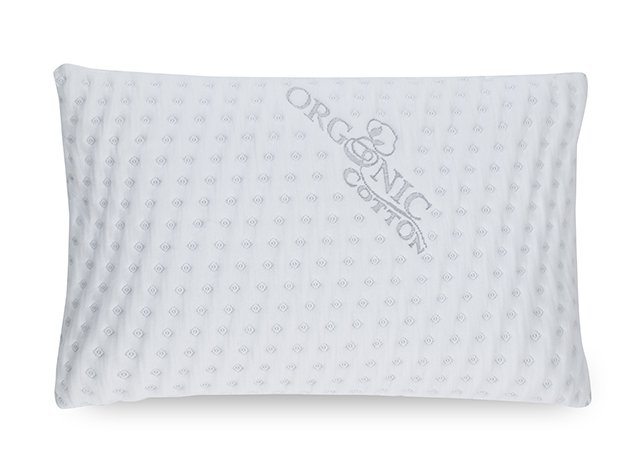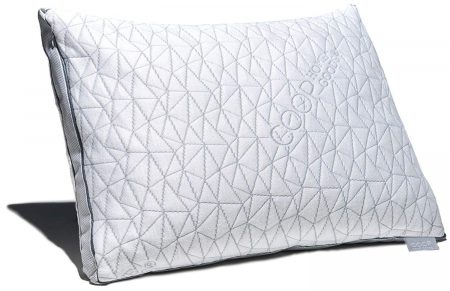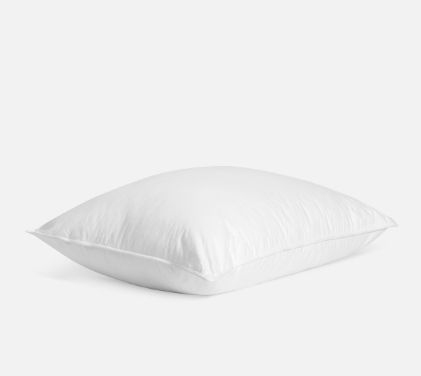Buying Guide - How to Shop for the Best Pillows for Shoulder Pain
Shoulder pain is a common experience for many people, affecting their day-to-day comfort and their ability to sleep well at night. Seventy percent of people will experience shoulder pain at some point in their lives.
With the right pillow, you can relieve your shoulder pain and sleep more deeply. The best pillow for shoulder pain involves finding the right loft, size, and materials for your body, sleep position, and mattress. Below we review how different types of shoulder pain can impact your sleep comfort, and share tips for finding the best pillow to match your needs and sleep style.
How Does Shoulder Pain Affect Sleep?
Shoulder pain occurs whenever the group of muscles, tendons, joints, and bones that make up the shoulder and socket become inflamed or irritated. Shoulder pain can be caused by a variety of issues. Some two million people incur a rotator cuff injury each year, such as a muscle tear or bursitis (where the fluid-filled, cushiony sacs between the bones become compressed or inflamed). This type of shoulder pain may occur due to injury or everyday wear-and-tear.
As people age, chronic shoulder issues become more common. Older adults, particularly older women, may develop adhesive capsulitis, or “frozen shoulder,” where the tissues in the shoulder joint stiffen up and cause pain. Even conditions like osteoarthritis aren’t reserved for knees and hips — they can also occur in the shoulder joint if the cartilage erodes.
How Shoulder Pain Negatively Impacts Sleep
When it comes to sleep, chronic pain of any kind creates a vicious cycle. When you’re in pain, it’s challenging to find a position where you can relax sufficiently to fall asleep. You may find yourself tossing and turning, scrunching up your pillow and trying out different positions to get comfortable. All of this takes up time that eats into your sleeping hours and causes frustration.
 Problematically, short sleep itself is one of the most consistent predictors of chronic pain. Sleep isn’t just a time to rest and watch your dreams — it’s an essential part of good health. While you doze off, your body works to heal and repair itself. Without sufficient sleep, your body doesn’t have time to repair the inflammation creating your shoulder pain. When you skimp on sleep, your emotional health suffers, too, so it becomes harder to cope with the emotional distress of living with chronic shoulder pain.
Problematically, short sleep itself is one of the most consistent predictors of chronic pain. Sleep isn’t just a time to rest and watch your dreams — it’s an essential part of good health. While you doze off, your body works to heal and repair itself. Without sufficient sleep, your body doesn’t have time to repair the inflammation creating your shoulder pain. When you skimp on sleep, your emotional health suffers, too, so it becomes harder to cope with the emotional distress of living with chronic shoulder pain.
Worse, when you do fall asleep, the sleep you get may not be as restorative as it could be — particularly if you are sleeping in such a way that worsens your shoulder pain. For your body to be able to perform its important repair work, you need to keep your spine aligned while you sleep, all the way from your pelvis to your neck. Sleeping on your side or your back are the best sleeping positions for keeping the spine in alignment, but you need to have the right pillow. Otherwise, you may wrench your neck and head out of alignment, causing more pressure on your shoulder.
Your pillow should provide comfort, not pain. In the following sections we discuss ways you can improve your sleep and lessen your shoulder pain.
Ways To Cope With Chronic Shoulder Pain
A doctor or physical therapist can recommend specific exercises, medications, and diet modifications to reduce your shoulder pain. In the meantime, there are many behavioral changes you can make, and minor exercises you can work into your everyday routine, in order to relieve your shoulder pain.
1. Avoid sleeping on the side experiencing pain. If the pain is isolated to one of your shoulders, avoid sleeping on that side. Sleep on your back or the other side instead.
2. Regularly stretch your neck and shoulders throughout the week. Harvard University recommends a seated shoulder stretch, triceps stretch, and chest stretch, all performed while seated upright in a chair. You may also want to consult a doctor to ensure you’re performing these correctly, so as to avoid worsening the pain or tightness in your shoulder.
- Shoulder Stretch: With your left hand on your right shoulder, cup your left elbow in your right hand. Roll your shoulders down and back, and then gently extend your left arm, pulling your left elbow across your chest. Hold for up to 30 seconds, before repeating on the other side.
- Triceps Stretch: Place your right palm on your right shoulder, and cup the right elbow with your left hand. Gently lift the right elbow upwards, supported by your left hand, until you feel a tight spot. Hold for up to 30 seconds, bring your elbow down, and repeat on the other side.
- Chest Stretch: Roll your shoulders down and back, and clasp your hands behind you, with the palms facing you and the fingers intertwined. Hold the stretch for up to 30 seconds and repeat.
3. Watch how you hold your phone or books when lying in bed. It’s best to avoid using electronics in bed, period, as the harsh blue light wakes up your brain and delays sleep. But, if you like to read or use your phone in bed, be careful of how you’re positioning yourself and whether you’re placing further stress on your shoulder, or straining it into an uncomfortable position.
4. Reevaluate your exercise routine. It’s possible you are doing something during the day that puts undue strain on your shoulder, such as heavy lifting or throwing your shoulder too hard during exercise. Could you rely on other muscle groups more, or perform the task in a less intense, slower way? Be careful before lifting weights or reaching for something high or out of the way. Generally avoid sudden movements.
5. Improve your posture. People with poor posture can be more prone to experience shoulder pain. If you find yourself slouching, remind yourself to sit upright. Use pillows or bolsters to help you sit well during the day. Walk with your shoulders back and aligned.
Pillow Positioning Options for People with Shoulder Pain
As you’ve probably discovered for yourself, certain pillow positions will provide more relief than others. Here are recommended pillow positioning options for individuals with shoulder pain:
- Back sleeping with a pillow in the armpit: Sleeping on your back is ideal for anyone with shoulder pain, as it allows you to lay flat, keeping the spine and neck straight, without applying too much pressure to either shoulder. To relieve shoulder pain while you sleep, try tucking a pillow into the armpit area of the affected shoulder. If your body attempts to roll onto your side while you sleep, this pillow will serve as an effective blocker, protecting the shoulder.
- Side sleeping with a pillow between the knees: This is a favorite position among all types of sleepers because it helps keep the spine aligned, while alleviating some pressure on the hips, preventing them from sinking too deeply into the mattress (and therefore causing misalignment). When sleeping in this position, make sure that your side body does not lose contact with the mattress — you should feel cradled and supported by the mattress surface.
- Side sleeping with a thin pillow under the back: If you’ve grown accustomed to sleeping on your side your whole life, it can be challenging to sleep any other way, even if one shoulder causes you pain. To make this position more comfortable, add a thin pillow underneath your back and upper hips. For those of you with broad shoulders, this fills in the extra space around your hips so your body can stay straighter, thereby relieving pressure in the shoulder area. Note: if you find that after doing this, your neck now tilts downward into your pillow, you’ll need to add a thin pillow or towel beneath your head pillow to keep your entire spine straight.
- Side sleeping with a pillow in the armpit: If only one of your shoulders is sore, try sleeping on the side with that shoulder facing up. You’ll need four pillows for this position, including your head pillow. Place one pillow in front of your stomach, and hug it. Place another pillow into the armpit area of the affected shoulder. Then, even out the spine with a final pillow placed between your legs, right up to the pelvis area.
You may have noticed we didn’t recommend any stomach sleeping positions above. Stomach sleeping is widely considered to be the unhealthiest sleeping position, simply because it causes your neck to twist to the side (and out of alignment with your spine), while your stomach and hips sink deeper into the mattress than the rest of your body (causing more misalignment further down the spine).
If you’re experiencing shoulder pain, prop pillows up around yourself to help train yourself to a new sleep position (either on your back or your side). You could also try sleeping on the stomach with a thin pillow beneath your pelvis, or perhaps without a head pillow at all, to aim for better spinal alignment.
Understanding Pillow Size, Shape, and Loft
Now, let’s review the mechanics and design of pillows. Bed pillows come in seven standard sizes: small, standard, super standard, queen, king, euro, and body pillow. The table below reviews the dimensions for each of these, as well as the recommended pillow case sizes.





 Problematically, short sleep itself is one of the
Problematically, short sleep itself is one of the